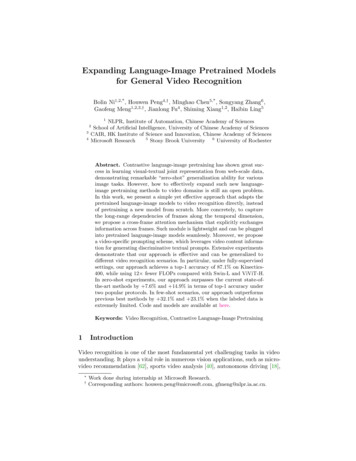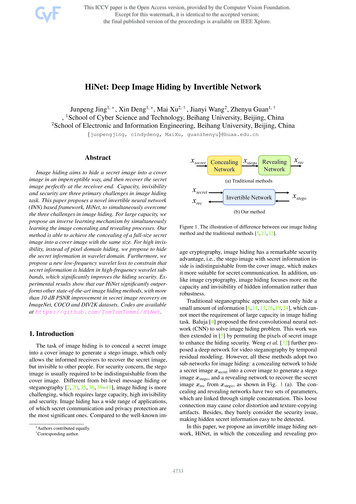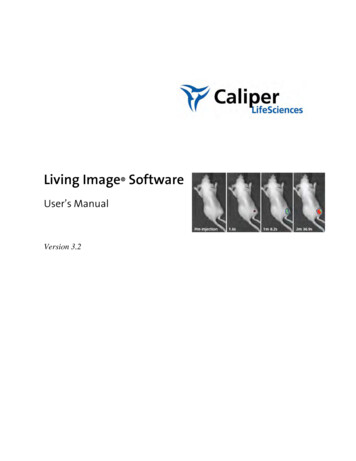
Transcription
Expanding Language-Image Pretrained Modelsfor General Video RecognitionBolin Ni1,2,* , Houwen Peng4,† , Minghao Chen5,* , Songyang Zhang6 ,Gaofeng Meng1,2,3,† , Jianlong Fu4 , Shiming Xiang1,2 , Haibin Ling51NLPR, Institute of Automation, Chinese Academy of SciencesSchool of Artificial Intelligence, University of Chinese Academy of SciencesCAIR, HK Institute of Science and Innovation, Chinese Academy of Sciences5Microsoft ResearchStony Brook University 6 University of Rochester234Abstract. Contrastive language-image pretraining has shown great success in learning visual-textual joint representation from web-scale data,demonstrating remarkable “zero-shot” generalization ability for variousimage tasks. However, how to effectively expand such new languageimage pretraining methods to video domains is still an open problem.In this work, we present a simple yet effective approach that adapts thepretrained language-image models to video recognition directly, insteadof pretraining a new model from scratch. More concretely, to capturethe long-range dependencies of frames along the temporal dimension,we propose a cross-frame attention mechanism that explicitly exchangesinformation across frames. Such module is lightweight and can be pluggedinto pretrained language-image models seamlessly. Moreover, we proposea video-specific prompting scheme, which leverages video content information for generating discriminative textual prompts. Extensive experimentsdemonstrate that our approach is effective and can be generalized todifferent video recognition scenarios. In particular, under fully-supervisedsettings, our approach achieves a top-1 accuracy of 87.1% on Kinectics400, while using 12 fewer FLOPs compared with Swin-L and ViViT-H.In zero-shot experiments, our approach surpasses the current state-ofthe-art methods by 7.6% and 14.9% in terms of top-1 accuracy undertwo popular protocols. In few-shot scenarios, our approach outperformsprevious best methods by 32.1% and 23.1% when the labeled data isextremely limited. Code and models are available at here.Keywords: Video Recognition, Contrastive Language-Image Pretraining1IntroductionVideo recognition is one of the most fundamental yet challenging tasks in videounderstanding. It plays a vital role in numerous vision applications, such as microvideo recommendation [62], sports video analysis [40], autonomous driving [18], †Work done during internship at Microsoft Research.Corresponding authors: houwen.peng@microsoft.com, gfmeng@nlpr.ia.ac.cn.
B. Ni et al.1 1 1 3Kinetics-400 Top-1 Accuracy (%)87.1%87Ours(L-14)3 384 4.0 PointsHigherSwin-L5x Speed Higher4x Views meSformer-LTimeSformer-HR86.086868587.11 54 3Kinetics-400 Top-1 Accuracy 20Throughput (clip/s)3070102103104Model FLOPs (Giga)105Fig. 1: Comparison with state-of-the-art methods on Kinetics-400 [22] in termsof throughput, the number of views, and FLOPs. Best viewed in color.and so on. Over the past few years, based upon convolutional neural networksand now transformers, video recognition has achieved remarkable progress [62,21].Most existing works follow a closed-set learning setting, where all the categoriesare pre-defined. Such method is unrealistic for many real-world applications,such as automatic tagging of web videos, where information regarding new videocategories is not available during training. It is thus very challenging for closed-setmethods to train a classifier for recognizing unseen or unfamiliar categories.Fortunately, recent work in large-scale contrastive language-image pretraining,such as CLIP [36], ALIGN [19], and Florence [54], has shown great potentialsin addressing this challenge. The core idea is to learn visual or visual-languagerepresentation with natural language supervision using web-scale image-text data.After pretraining, natural language is used to reference learned visual concepts(or describe new ones), thus enabling zero/few-shot transfer of the models todownstream tasks. Inspired by these works [36,19,54], we consider to use text asthe supervision signals to learn a new video representation for general recognitionscenarios, including zero-shot, few-shot, and fully-supervised.However, directly training a language-video model is unaffordable for manyof us, because it requires large-scale video-text pretraining data as well as amassive number of GPU resources (e.g., thousands of GPU days). A feasiblesolution is to adapt the pretrained language-image models to video domain. Veryrecently, there are several studies exploring how to transfer the knowledge fromthe pretrained language-image models to other downstream tasks, e.g., pointcloud understanding [58] and dense prediction [37,59]. However, the transferand adaptation to video recognition is not well explored. When adapting thepretrained cross-modality models from image to video domain, there are two keyissues to be solved: 1) how to leverage the temporal information contained invideos, and 2) how to acquire discriminative text representation for a video.For the first question, we present a new architecture for video temporalmodeling. It consists of two key components: a cross-frame communicationtransformer and a multi-frame integration transformer. Specifically, the cross-
X-CLIP3frame communication transformer takes raw frames as input and provides a framelevel representation using a pretrained language-image model, while allowinginformation exchange between frames with message tokens. Each message tokennot only depicts the semantics of the current frame, but also communicateswith other frames to model their dependencies. The multi-frame integrationtransformer then simply transfer the frame-level representations to video-level.For the second question, we employ the text encoder pretrained in the languageimage models and expand it with a video-specific prompting scheme. The key ideais to leverage video content information to enhance text prompting. The intuitionbehind is that appropriate contextual information can help the recognition. Forexample, if there is extra video content information about “in the water”, theactions “swimming” and “running” will be much easier to be distinguished. Incontrast to prior work manually designing a fixed set of text prompts, this workproposes a learnable prompting mechanism, which integrates both semantic labelsand representation of videos for automatic prompt generation.With the above two issues addressed, we can smoothly adapt the existingimage-level cross-modality pretrained models to video domains. Without loss ofgenerality, here we choose the available CLIP [36] and Florence [54] models andeXpand them for general video recognition, forming new model families called XCLIP and X-Florence, respectively. Comprehensive experiments demonstrate ourexpanded models are generally effective. In particular, under the fully-supervisedsetting, X-CLIP-L/14 achieves competitive performance on Kinetics-400/600with a top-1 accuracy of 87.1%/88.3%, surpassing ViViT-H [3] by 2.3%/2.5%while using 12 fewer FLOPs, as shown in Fig. 1. In zero-shot experiments,X-Florence surpasses the state-of-the-art ActionCLIP [48] by 7.6% and 14.9%under two popular protocols. In few-shot experiments, X-CLIP outperforms otherprevailing methods by 32.1% and 23.1% when the data is extremely limited.In summary, our contributions are three-fold:– We propose a new cross-frame communication attention for video temporalmodeling. This module is light and efficient, and can be seamlessly pluggedinto existing language-image pretrained models, without undermining theiroriginal parameters and performance.– We design a video-specific prompting technique to yield instance-level textual representation automatically. It leverages video content information toenhance the textual prompt generation.– Our work might pave a new way of expanding existing large-scale languageimage pretrained models for general video recognition and other potentialvideo tasks. Extensive experiments demonstrate the superiority and goodgeneralization ability of our method under various learning configurations.2Related WorkVisual-language Pretraining. Visual-language pretraining has achieved remarkable progress over the past few years [43,42,31,61]. In particular, contrastivelanguage-image pretraining demonstrates very impressive “zero-shot” transfer
4B. Ni et al.and generalization capacities [36,19,54]. One of the most representative works isthe recent CLIP [36]. A large amount of follow-up works have been proposed toleverage the pretrained models for downstream tasks. For example, CoOp [60],CLIP-Adapter [15] and Tip-Adapter [57] use the pretrained CLIP for improving the few-shot transfer, while PointCLIP [58] and DenseCLIP [37,59] transferthe knowledge to point cloud understanding and dense prediction, respectively.VideoCLIP [51] extends the image-level pretraining to video by substituting theimage-text data with video-text pairs [31]. However, such video-text pretrainingis computationally expensive and requires a large amount of curated video-textdata which is not easy to acquire. In contrast, our method directly adapts theexisting pretrained model to video recognition, largely saving the training cost.There are two concurrent works mostly related to ours. One is ActionCLIP[48], while the other is [20]. Both of them introduce visual-language pretrainedmodels to video understanding. ActionCLIP proposes a “pretrain, prompt andfinetune” framework for action recognition, while [20] proposes to optimize afew random vectors for adapting CLIP to various video understanding tasks. Incontrast, our method is more general. It supports adapting various languageimage models, such as CLIP and Florence [54], from image to video. Moreover,we propose a lightweight and efficient cross-frame attention module for videotemporal modeling, while presenting a new video-specific text prompting scheme.Video Recognition. One key factor to build a robust video recognition modelis to exploit the temporal information. Among many methods, 3D convolutionis widely used [44,45,35,50], while it suffers from high computational cost. Forefficiency purposes, some studies [45,35,50] factorize convolutions across spatialand temporal dimensions, while others insert the specific temporal modules into2D CNNs [27,25,30]. Nevertheless, the limited receptive field of CNNs gives therise of transformer-based methods [3,5,29,11,53], which achieve very promisingperformance recently. However, these transformer-based methods are eithercomputationally intensive or insufficient in exploiting the temporal information.For example, ViViT [3] disregards the temporal information in the early stage.Video Swin [29] utilizes 3D attention while having high computational cost.The temporal modeling scheme in our method shares a similar spirit withthe recent proposed video transformers, i.e., VTN [32], ViViT [3], and AVT[17]. They all use a frame-level encoder followed by a temporal encoder, but ourmethod has two fundamental differences. 1) In [32,3,17], each frame is encodedseparately, resulting in no temporal interaction before final aggregation. This latefusion strategy does not fully make use of the temporal cues. By contrast, ourmethod replaces the spatial attention with the proposed cross-frame attention,which allows global spatio-temporal modeling for all frames. 2) Similar to previousworks [29,11,12,5], both ViViT [3] and VTN [32] adopt a dense temporal samplingstrategy and ensemble the predictions of multiple views at inference, which istime-consuming. On the contrary, we empirically analyze different samplingmethods for late fusion, and demonstrate that a sparse sampling is good enough,achieving better performance with fewer FLOPs than the dense strategy, asverified in Sec. 4.5 (Analysis).
X-CLIP5Maximize the score for grouth-truth.Multi-frame Integration Transformer.1Video-specific Prompting000111222Text EncoderAir drum.Cry345.TCross-frame Communication Transformer.2333444555.NNNPatch Embedding.Pretrained initializationSwimPartially pretrained initializationRandom initializationFig. 2: An overview of our framework. The details are elaborated in Sec. 3.1.3ApproachIn this section, we present our proposed framework in detail. First, we brieflyoverview our video-text framework in Sec. 3.1. Then, we depict the architectureof the video encoder, especially for the proposed cross-frame attention in Sec. 3.2.Finally, we introduce a video-specific prompting scheme in Sec. 3.3.3.1OverviewMost prior works in video recognition learn discriminative feature embeddingssupervised by a one-hot label [3,5,12,47]. While in this work, inspired by therecent contrastive language-image pretraining [36,19,54], we propose to use text asthe supervision, since the text provides more semantic information. As shown inFig. 2, our method learns to align the video representation and its correspondingtext representation by jointly training a video encoder and a text encoder.Rather than pretraining a new video-text model from scratch, our method isbuilt upon prior language-image models and expands them with video temporalmodeling and video-adaptive textual prompts. Such a strategy allows us to fullytake advantage of existing large-scale pretrained models while transferring theirpowerful generalizability from image to video in a seamless fashion.Formally, given a video clip V V and a text description C C, where V isa set of videos and C is a collection of category names, we feed the video V intothe video encoder fθv and the text C into the text encoder fθc to obtain a videorepresentation v and a text representation c respectively, where{\bf {v}} f {\theta v}(V), \ \ {\bf {c}} f {\theta c}(C).(1)Then, a video-specific prompt generator fθp is employed to yield instance-leveltextual representation for each video. It takes the video representation v andtext representation c as inputs, formulated as{\hat {\bf {c}}} f {\theta p}(\bf {c}, \bf {v}).(2)
6B. Ni et al.FFNFFNFFNIntra-FrameDiffusion AttentionIntra-FrameDiffusion AttentionIntra-FrameDiffusion Attention1) Joint Space-TimeAttention (ST)2) Divided Space-TimeAttention (S T)Cross-frameFusion Attention.(a) Cross-frame Communication Transformer Block4) Cross-frame3) Window-based Space-TimeAttention (S T) (Ours)Attention (ST)(b) Various Space-Time AttentionsFig. 3: (a) Cross-frame Attention. (b) compares different space-time attentionmechanisms used in existing video transformer backbones [3,5,29].Finally, a cosine similarity function sim(v, ĉ) is utilized to compute the similaritybetween the visual and textual representations:{\rm sim}({\bf {v}},\hat {\bf {c}}) {\langle {\bf {v}}, \hat {\bf {c}}\rangle } / \big ({\left \ {\bf {v}}\right \ \left \ \hat {\bf {c}}\right \ }\big ). \label {eq:cosine similarity}(3)The goal of our method is to maximize the sim(v, ĉ) if V and C are matchedand otherwise minimize it.3.2Video EncoderOur proposed video encoder is composed of two cascaded vision transformers: across-frame communication transformer and a multi-frame integration transformer.The cross-frame transformer takes raw frames as input and provides a framelevel representation using a pretrained language-image model, while allowinginformation exchange between frames. The multi-frame integration transformerthen simply integrates the frame-level representations and outputs video features.Specifically, given a video clip V RT H W 3 of T sampled frames withH and W denote the spatial resolution, following ViT [10], the t-th frame isP 2 3divided into N non-overlapping patches {xt,i }Nwith each of sizei 1 RP P pixels, where t {1, · · · , T } denotes the temporal index, and N HW/P 2 .The patches {xt,i }Ni 1 are then embedded into patch embeddings using a linear3P 2 Dprojection E R. After that, we prepend a learnable embedding xclass tothe sequence of embedded patches, called [class] token. Its state at the outputof the encoder serves as the frame representation. The input of the cross-framecommunication transformer at the frame t is denoted as:{\bf {z}} {(0)} {t} [{\bf {x}} {class}, {\bf {Ex}} {t,1}, {\bf {Ex}} {t,2}, \cdots ,{\bf {Ex}} {t,N}] {\bf {e}} {spa},where espa represents the spatial position encoding.(4)
X-CLIP7Then we feed the patch embeddings into an Lc -layer Cross-frame Communication Transformer (CCT) to obtain the frame-level representation ht :\begin {aligned} {\bf {z}} {(l)} {t} & \operatorname {CCT} {(l)}({{\bf {z}} {(l-1)} {t}}), l 1, \cdots , L c\\ {\bf {h}} t & {\bf {z}} {(L c)} {t, 0}, \end {aligned}(5)(L )where l denotes the block index in CCT, zt,0c represents the final output of the[class] token. CCT is built-up with the proposed cross-frame attention, as willbe elaborated later.At last, the Lm -layer Multi-frame Integration Transformer (MIT) takes allframe representation H [h1 , h2 , · · · , hT ] as input and outputs the video-levelrepresentation v as following:{\bf {v}} \operatorname {AvgPool}(\operatorname {MIT}({\bf {H}} {\bf {e}} {temp})),(6)where AvgPool and etemp denote the average pooling and temporal positionencoding, respectively. We use standard learnable absolute position embeddings[46] for espa and etemp . The multi-frame integration transformer is constructedby the standard multi-head self-attention and feed-forward networks [46].Cross-frame Attention. To enable a cross-frame information exchange, wepropose a new attention module. It consists of two types of attentions, i.e.,cross-frame fusion attention (CFA) and intra-frame diffusion attention (IFA),with a feed-forward network (FFN). We introduce a message token mechanismfor each frame to abstract, send and receive information, thus enabling visualinformation to exchange across frames, as shown in Fig. 3(a). In detail, the(l)message token mt for the t-th frame at the l-th layer is obtained by employing(l 1)a linear transformation on the [class] token zt,0 . This allows message tokensto abstract the visual information of the current frame.Then, the cross-frame fusion attention (CFA) involves all message tokens tolearn the global spatio-temporal dependencies of the input video. Mathematically,this process at l-th block can be expressed as:\hat {{\bf {M}}} {(l)} {\bf {M}} {(l)} \operatorname {CFA}({\operatorname {LN}(\bf {M}} {(l)})), \label {equ:8}(l)(l)(7)(l)where M̂(l) [m̂1 , m̂2 , · · · , m̂T ] and LN indicates layer normalization [4].Next, the intra-frame diffusion (IFA) takes the frame tokens with the associated message token to learn visual representation, while the involved messagetoken could also diffuse global spatio-temporal dependencies for learning. Mathematically, this process at l-th block can be formulated as:[\hat {{\bf {z}}} {(l)} t, \bar {\bf {m}} t {(l)}] [{\bf {z}} {(l-1)} t, \hat {{\bf {m}}} t {(l)}] \operatorname {IFA}(\operatorname {LN}([{\bf {z}} {(l-1)} t, \hat {{\bf {m}}} t {(l)}])),(8)where [·, ·] concatenates the features of frame tokens and message tokens.Finally, the feed-forward network(FFN) performs on the frame tokens as:{\bf {z}} {(l)} t \hat {{\bf {z}}} {(l)} t \operatorname {FFN}(\operatorname {LN}(\hat {{\bf {z}}} {(l)} t)).\label {equ:10}(9)
8B. Ni et al.Note that the message token is dropped before the FFN layer and does notpass through the next block, since it is generated online and used for framescommunication within each block. Alternating the fusion and diffusion attentionsthrough Lc blocks, the cross-frame communication transformer (CCT) can encodethe global spatial and temporal information of video frames. Compared to otherspace-time attention mechanisms [3,5,29], as presented in Fig. 3(b), our proposedcross-frame attention models the global spatio-temporal information while greatlyreducing the computational cost.Initialization. When adapting the pretrained image encoder to the video encoder, there are two key modifications. 1) The intra-frame diffusion attention (IFA)inherits the weights directly from the pretrained models, while the cross-framefusion attention (CFA) is randomly initialized. 2) The multi-frame integrationtransformer is appended to the pretrained models with random initialization.3.3Text EncoderWe employ the pretrained text encoder and expand it with a video-specificprompting scheme. The key idea is to use video content to enhance the textrepresentation. Given a description C about a video, the text representation cis obtained by the text encoder, where c fθc (C). For video recognition, howto generate a good text description C for each video is a challenging problem.Previous work, such as CLIP [36], usually defines textual prompts manually,such as “A photo of a {label}”. However, in this work, we empirically showthat such manually-designed prompts do not improve the performance for videorecognition (as presented in Tab. 9). In contrast, we just use the “{label}” asthe text description C and then propose a learnable text prompting scheme.Video-specific prompting. When understanding an image or a video, humancan instinctively seek helps from discriminative visual cues. For example, theextra video semantic information of “in the water” will make it easier todistinguish “swimming” from “running”. However, it is difficult to acquire suchvisual semantics in video recognition tasks, because 1) the datasets only providethe category names, such as “swimming” and “running”, which are pre-definedand fixed; and 2) the videos in the same class share the identical categoryname, but their visual context and content are different. To address these issues,we propose a learnable prompting scheme to generate textual representationautomatically. Concretely, we design a video-specific prompting module, whichtakes the video content representation z̄ and text representation c as inputs. Eachblock in the video-specific prompting module is consisting of a multi-head selfattention (MHSA) [46] followed by a feed-forward network to learn the prompts,\bar {\bf {c}} {\bf {c}} \operatorname {\textcolor {black}{MHSA}}({\bf {c}}, \bar {\bf {z}}) \text { and } \tilde {\bf {c}} \bar {\bf {c}} \operatorname {FFN}(\bar {\bf {c}}),N d(L ){zt c }Tt 1(10)where c is the text embedding, z̄ Ris the average ofalong thetemporal dimension, and c̃ is the video-specific prompts. We use text representation c as query and the video content representation z̄ as key and value. This
X-CLIP9Table 1: Comparison with state-of-the-art on Kinetics-400. We report the FLOPsand throughput per view. indicates video-text pretraining.CLIP-400MMethodPretrain Frames Top-1 Top-5Methods with random initializationMViTv1-B, 64 3 [11]6481.2 95.1Methods with ImageNet pretrainingUniformer-B [24]IN-1k3283.0 95.4TimeSformer-L [5]IN-21k9680.7 94.7Mformer-HR [33]IN-21k1681.1 95.2Swin-L [29]IN-21k3283.1 95.9Swin-L (384 ) [29]IN-21k3284.9 96.7MViTv2-L (312 ) [26]IN-21k4086.1 97.0Methods with web-scale image pretrainingViViT-H/16x2 [3]JFT-300M3284.8 95.8TokenLearner-L/10 [39] JFT-300M85.4 96.3CoVeR [55]JFT-3B87.2Methods with web-scale language-image pretrainingActionCLIP-B/16 [48] CLIP-400M 3283.8 96.2A6 [20]CLIP-400M 1676.9 93.5MTV-H [53]WTS 3289.1 98.2X-Florence (384 )FLD-900M886.2 96.6X-FlorenceFLD-900M3286.5 96.9X-CLIP-B/16IN-21k881.1 94.7X-CLIP-B/32880.4 95.0X-CLIP-B/321681.1 95.5X-CLIP-B/16883.8 96.7X-CLIP-B/161684.7 96.8X-CLIP-L/14887.1 97.6X-CLIP-L/14 (336 )1687.7 97.4Views FLOPs(G) Throughput3 345574 31 310 34 310 55 325923809596042107282836-4 34 31 383164076--10 34 34 34 34 34 34 34 34 34 34 2implementation allow the text representation to extract the related visual contextfrom videos. We then enhance the text embedding c with the video-specificprompts c̃ as follows, ĉ c αc̃, where α is a learnable parameter with aninitial value of 0.1. The ĉ is finally used for classification in Eq. (3).4ExperimentsIn this section, we conduct experiments on different settings, i.e., fully-supervised,zero-shot and few-shot, followed by the ablation studies of the proposed method.4.1Experimental SetupArchitectures and Datasets. We expand CLIP and Florence to derive fourvariants: X-CLIP-B/32, X-CLIP-B/16, X-CLIP-L/14 and X-Florence, respectively. X-CLIP-B/32 adopts ViT-B/32 as parts of the cross-frame communicationtransformer, X-CLIP-B/16 uses ViT-B/16, while X-CLIP-L/14 employs ViTL/14. For all X-CLIP variants, we use a simple 1-layer multi-frame integrationtransformer, and the number of the video-specific prompting blocks is 2. We
10B. Ni et al.Table 2: Comparison with state-of-the-art on Kinetics-600.MethodPretrain Frames Top-1Methods with random initializationMViT-B-24, 32 3 [11]3283.8Methods with ImageNet pretrainingSwin-L (384 ) [29]IN-21k3286.1Methods with web-scale pretrainingViViT-L/16x2 320 [3] JFT-300M3283.0ViViT-H/16x2 [3]JFT-300M3285.8TokenLearner-L/10 [39] JFT-300M86.3Florence (384 ) [54]FLD-900M87.8CoVeR [55]JFT-3B87.9MTV-H [53]WTS 3289.6X-CLIP-B/16885.3X-CLIP-B/16CLIP-400M 1685.8X-CLIP-L/14888.3Top-5 Views FLOPs Throughput96.3 5 1236-97.3 10 5 2107- 3333333992831640763705145287658evaluate the efficacy of our method on four benchmarks: Kinetics-400&600 [22,7],UCF-101 [41] and HMDB-51 [23]. More details about architectures and datasetsare provided in the supplementary materials.4.2Fully-supervised ExperimentsTraining and Inference. We sample 8 or 16 frames in fully-supervised experiments. The detailed hyperparameters are showed in the supplementary materials.Results. In Tab. 1, we report the results on Kinetics-400 and compare withother SoTA methods under different pretraining, including random initialization,IN-1k/21k [9] pretraining, web-scale image and language-image pretraining.Compared to the methods pretrained on IN-21k [9], our X-CLIP-B/168f (8frames) surpasses Swin-L [28] by 0.7% with 4 fewer FLOPs and running 5 faster(as presented in Fig. 1). The underlying reason is that the shift-windowattention in Swin is inefficient. Also, our X-CLIP-L/148f outperforms MViTv2-L[26] by 1.0% with 5 fewer FLOPs. In addition, when using IN-21k pretraining,our method surpasses TimeSformer-L [5] with fewer FLOPs.When compared to the methods using web-scale image pretraining, our XCLIP is also competitive. For example, X-CLIP-L/148f achieves 2.3% higheraccuracy than ViViT-H [3] with 12 fewer FLOPs. MTV-H [53] achieves betterresults than ours, but it uses much more pretraining data. Specifically, MTV-Huses a 70M video-text dataset including about 17B images, which are much largerthan the 400M image-text data used in CLIP pretraining.Moreover, compared to ActionCLIP [48], which also adopt CLIP as thepretrained model, our X-CLIP-L/148f is still superior, getting 3.3% higheraccuracy with fewer FLOPs. There are two factors leading to the smaller FLOPsof our method. One is that X-CLIP does not use 3D attention like [29] and hasfewer layers. The other factor is that X-CLIP samples fewer frames for each videoclip, such as 8 or 16 frames, while ActionCLIP [48] using 32 frames.
X-CLIPTable 3: Zero-shot performances onHMDB51 [23] and UCF101 [41].MethodHMDB-51UCF-101MTE [52]ASR [49]ZSECOC [34]UR [63]TS-GCN [14]E2E [6]ER-ZSAR [8]ActionCLIP [48]19.7 1.621.8 0.922.6 1.224.4 1.623.2 3.032.735.3 4.640.8 5.415.8 24.4 15.1 17.5 34.2 4851.8 58.3 X-CLIP-B/16X-Florence1.31.01.71.63.12.93.444.6 5.2 72.0 2.3( 3.8)( 13.7)48.4 4.9 73.2 4.2( 7.6)( 14.9)11Table 4: Zero-shot performance onKinetics-600 [7].MethodDEVISE [13]ALE [1]SJE [2]ESZSL [38]DEM [56]GCN [16]ER-ZSAR [8]X-CLIP-B/16X-FlorenceTop-1 Acc. Top-5 Acc.23.823.422.322.923.622.342.1 0.30.80.61.20.70.61.451.050.348.248.349.549.773.1 0.61.40.40.80.40.60.365.2 0.4 86.1 0.8( 23.1)( 13.0)68.8 0.9 88.4 0.6( 26.7)( 15.3)In addition, we report the results on Kinetics-600 in Tab. 2. Using only 8frames, our X-CLIP-B/168f surpasses ViViT-L, while using 27 fewer FLOPs.More importantly, our X-CLIP-L/148f achieves 88.3% top-1 accuracy while using5 fewer FLOPs compared to the current state-of-the-art method MTV-H [53].From the above fully-supervised experiments, we can observe that, our XCLIP method achieves very competitive performance compared to prevailingvideo transformer models [55,54,53,48,20]. This mainly attributes to two factors.1) The proposed cross-frame attention can effectively model temporal dependencies of video frames. 2) The joint language-image representation is successfullytransferred to videos, unveiling its powerful generalization ability for recognition.4.3Zero-shot ExperimentsTraining and Inference. We pretrain X-CLIP-B/16 on Kinetics-400. More details about the evaluation protocols are provided in the supplementary materials.Results. Zero-shot video recognition is very challenging, because the categories in the test set are unseen to the model during training. We report theresults in Tab. 3 and Tab. 4. On HMDB-51 [23] and UCF-101 [41] benchmarks,our X-CLIP outperforms the previous best results by 3.8% and 13.7% interms of top-1 accuracy respectively, as reported in Tab. 3. On Kinetics-600 [7] aspresented in Tab. 4, our X-CLIP outperforms the state-of-the-art ER-ZSAR [8] by 23.1%. Such remarkable improvements can be attributed to the proposed videotext learning framework, which leverages the large-scale visual-text pretrainingand seamlessly integrates temporal cues and textual prompts.4.4Few-shot ExperimentsTraining and Inference. A general K-shot setting is considered, i.e., K examples are sampled from each category randomly for training. We compare withsome representative methods. More details about the comparison methods andevaluation protocols are provided in the supplementary materials.
12B. Ni et al.Table 5: Few-shot results. Top-1 accuracy is report
The multi-frame integration transformer is constructed by the standardmulti-head self-attentionand feed-forward networks [46]. Cross-frame Attention. To enable a cross-frame information exchange, we propose a new attention module. It consists of two types of attentions, i.e., cross-frame fusion attention (CFA) and intra-frame diffusion .










